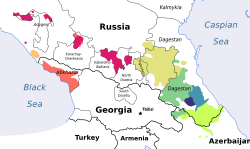|
Tabasaran language
Tabasaran (also written Tabassaran) is a Northeast Caucasian language of the Lezgic branch. It is spoken by the Tabasaran people in the southern part of the Russian Republic of Dagestan. There are two main dialects: North (Khanag) and South Tabasaran. It has a literary language based on the Southern dialect, one of the official languages of Dagestan. Tabasaran is an ergative language. The verb system is relatively simple; verbs agree with the subject in number, person and (in North Tabasaran) class. North Tabasaran has two noun classes (that is, grammatical gender), whereas Southern Tabasaran lacks noun classes / gender. Geographical distributionIt is spoken in the basin of Upper Rubas-nir and Upper Chirakh-nir. PhonologyConsonants
The post-alveolar sibilants may be whistled. Vowels
Vowel sounds of Tabasaran are [i, y, ɛ, æ, ɑ, u]. Writing systemTabasaran has been written using Cyrillic since 1938 (from 1928 to 1938 the Latin alphabet was used as a base for the Tabasaran writing system).
Note: The letters indicated in orange are encountered only in loanwords from Russian. Grammar
It is highly probable that Tabasaran is an active language of the fluid-S type. CasesTabasaran was listed in the Guinness Book of World Records as having the largest case system in the world, with 48. Hjelmslev (1935) claimed that Tabasaran had the 'empirical maximum' number of cases, with 52 (though 2 occur only on adjectives). However, such claims are based on a sloppy analysis of 'case', and other languages such as Tsez would have even larger counts under such definitions. Comrie & Polinsky (1998) analyze the system as having 14 case morphemes (counting the absolutive with no suffix) in southern dialects (including the standard language) and 15 in northern dialects.[3][4] These include 4 core/argument cases (absolutive, ergative, genitive -n and dative -z). The absolutive is the citation form. The ergative, which may be irregular but typically ends in -i, functions as the stem for all other cases. There are also 7 or 8 locative case suffixes: -ʔ 'in', -xy 'at', -h 'near / in front' (neutralized with 'at' in the south), -ʔin 'on' (horizontal), -k 'on' (vertical), -kk 'under', -q 'behind' and -ghy 'among'. The locative cases may take an additional suffix, allative -na or ablative -an, for 21 or 24 combinations. All of these, as well as the dative, can take a further suffix -di to mark the location as less specific, for 47 (southern) to 53 (northern) combinations of case suffixes. SamplesUwu aldakurawu. "Уву алдакураву." — "You are falling." Uzuz uwu kkunduzuz. "Узуз уву ккундузуз." — "I love you." Uwu fudžuwa? "Уву фужува?" — "Who are you?" Fici wuna? "Фици вуна?" — "How are you?" Zakur ʕürza. "Закур гъюрза." — "I'll come tomorrow." Uzu kana qheza. "Узу кана хъэза." — "I'll be back." References
External links
|
||||||||||||||||||||||||||||||||||||||||||||||||||||||||||||||||||||||||||||||||||||||||||||||||||||||||||||||||||||||||||||||||||||||||||||||||||||||||||||||||||||||||||||||||||||||||||||||||||||||||||||||||||||||||||||||||||||||||||||||||||||||||||||||||||||||||||||||||||||||||||||||



